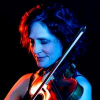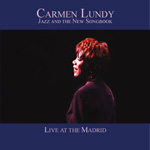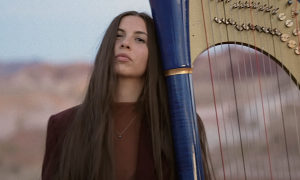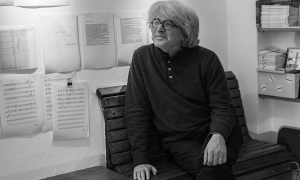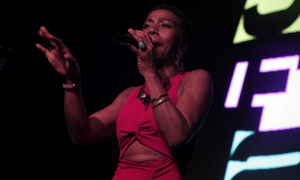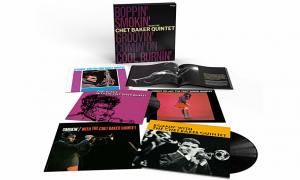Home » Jazz Articles » Interview » Jenny Scheinman: Touching Many Strings
Jenny Scheinman: Touching Many Strings
I want to make music that the people like. That
 Jenny Scheinman, a violinist of eclectic style and taste, has been coming into her own in the music world; the jazz music world, if you will. This young woman, raised in an ultra rural section of California, now imbedded in the Big Apple, is full of music. She's also down to earth, and so are the sounds and ideas that spring from her mind and heart.
Jenny Scheinman, a violinist of eclectic style and taste, has been coming into her own in the music world; the jazz music world, if you will. This young woman, raised in an ultra rural section of California, now imbedded in the Big Apple, is full of music. She's also down to earth, and so are the sounds and ideas that spring from her mind and heart. She comes off, in first encounter, as curious, open, and not afraid of taking a chance. Not unconcerned, but perhaps unflappable. She's not snobbish of music styles or forms. She plays delicately; and with passion. She spent some time in the San Francisco Bay area, but it seems as though it would be very easy to envision her there in a different time. Like the 1960s when the area was flowing with different music vibes, from the Dead, to Country Joe, to Jefferson Airplane (move over Papa John Creach) and many mutations of blues and rock and folk and jazz in between. In speaking with Scheinman, a vibe came across that is would not be hard to picture her bowing along side Jerry Garcia one day, Grace Slick the next and then Jorma Kaukonen. Or going over to sit with Dewey Redman, who also was in the Bay area in those years.
It's just a feeling. But not far fetched, considering her attitude, and, indeed, her background, that San Francisco in that era would have welcomed her.
Scheinman has already exhibited a penchant for playing in different scenarios, even upon her move to the hustle and bustle of New York City in 1999. She can be found playing alongside banjo expert Danny Barnes, or with guitarist Bill Frisell. She's performed in a trio with trumpeter Ron Miles in collaboration with a cartoonist, Bill Woodring. She's played Balkan music with Jim Black and Chris Speed, in a duo with pianist Myra Melford. She even had a brush with pop greatness playing on the Norah Jones mega-hit album Come Away With Me. She's also busked on the streets of San Francisco. She sometimes sings (though not jazz, she says, counting Lucinda Williams among her favorite singers) and plays piano as well.
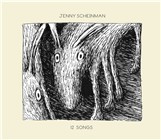 "I was a real serious classical pianist when I was young, she says. "That was an influence. I really didn't start buying records until I was a teenager. I listened to my parents record collection. My influences partly are career influences --- what I've been hired to do. I've always made a living as a musician, so I've played all different kinds of things. Things that people want violins for, whether it's string quartet or a violin for their klezmer band, or folk music. Tons of Stephane Grapelli-Django Reinhardt music, because that's part of the history.
"I was a real serious classical pianist when I was young, she says. "That was an influence. I really didn't start buying records until I was a teenager. I listened to my parents record collection. My influences partly are career influences --- what I've been hired to do. I've always made a living as a musician, so I've played all different kinds of things. Things that people want violins for, whether it's string quartet or a violin for their klezmer band, or folk music. Tons of Stephane Grapelli-Django Reinhardt music, because that's part of the history.
"I was just on tour with Madeleine Peyroux. I really got into her whole world of music and met some wonderful musicians. And then Bill [Frisell]. He is a huge influence. I was a fan of his before he hired me for so much stuff. He's a big influence.
Make no mistake. Jenny Scheinman is a serious musician who is getting more notoriety with each performance and recording. Her latest, 12 Songs (Cryptogramophone, 2005) is a good example of her intriguing mind. The seven musicians unveiling the all-original works include Frisell and cornetist Ron Miles. It's gotten very positive critical reaction, with good reason. The melodies are interesting and the group, never in virtuoso form, serves the songs the way Scheinman envisions them. They evoke different moods. And in the violinist's mind, she sees them as adaptive to other modes.
"People hear straight-ahead a lot from the rhythm section. There's nothing in swing 4/4 time on the record. I think if you took all those melodies and put them over some sort of medium swing thing, or fast swing thing, they'd probably sound pretty jazzy. They're not those types of rhythms. The rhythm section isn't really a very jazzy rhythm section. (Rachelle Garniez, piano, accordion, claviola; Tim Luntzel, bass; Don Rieser, drums). That was intentional. My other records are with much more jazzy rhythm sections.
"They immediately go toward less orchestral, less sculptural, more spontaneous, interactive improvisations that don't have that much to do with the melodies, says Scheinman. "I guess all my records are like that, compared to straight-ahead jazz records. Mine are much more compositionally focused, melodically driven. But this one is the most like that.
She's happy for the good reception, but is already on the way to writing more music, having spent most of three days in December doing not much more than that. She's works hard with great focus in the studio, but once the work is complete, is almost taken by surprise when she hears it played.
Refreshing.
"I haven't listened to it since I made it. I listened to it so much making it. But I've heard it on the radio a couple times and I've thought, 'Wow. It was pretty good.' It's such a trip to hear music that I'm so close to coming out, she says thoughtfully. "I heard it at the Village Vanguard one night, which is a big honor. But it sounded pretty good in there. I'm happy with it. It's out there now. I certainly worked my ass off on this thing.
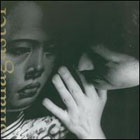 "There are some musicians that just go into the studio, put up some mics, record, and then send it to the label and the label mixes it, makes the artwork, sequences it, puts it out. If I did that, I'd probably make a lot more records. But, fortunately or unfortunately, I agonize over every detail. So I know it really well. I am happy with it, for sure.
"There are some musicians that just go into the studio, put up some mics, record, and then send it to the label and the label mixes it, makes the artwork, sequences it, puts it out. If I did that, I'd probably make a lot more records. But, fortunately or unfortunately, I agonize over every detail. So I know it really well. I am happy with it, for sure.
"This is the biggest band I've recorded. My last two records were five people and before that was four. Just adding two people added the depth that I wanted, which is that kind of orchestral quality that I hear in it. But is also is trickier for mixing, in my sense of how I wanted it to sound. I didn't want it to sound like a jazz record. I wanted it to sound really cohesive; little sculptures.
She said there were a lot of overdubs done, but almost none were used, except for a trumpet part on "She Couldn't Believe It Was True. The extra music "was in my head and I wanted to see what it sounded like. When it actually came to mixing it, I didn't use any of that.
The extra music came in handy, however, at the release party for 12 Songs, which involved an orchestra with 20 strings in addition to the band. "I had to really arrange it. I took some of the parts that actually weren't on the record — that we had overdubbed, but not used — enriching harmony parts that seemed a little too rich — I'm not into things that are too rich — but with all the strings it was fun. And it was live, she said.
Is it a jazz record?
"I think that's a jazz record, pretty much, she says as if weighing the matter while she speaks. "Stuff is all changing. There's the Internet. People are listening to all sorts of stuff. I think in 10 years the only people that will be playing what we call 'mainstream jazz' will be somewhat historically oriented.
"I'm a huge appreciator of jazz and I have played a lot of it, and write for jazz musicians, because they are practiced intuitors. They can flesh out things. They can keep it always different. I get really bored in bands where I have to play the same thing. As much as I like pop music, I can't really stand to play it. In terms of recordings, I do like crafted things, rather than long solos. I've never had a bass solo on my records. I don't think I've ever had a drum solo. That's not very jazzy, not to have those on your record. What other genre's have bass solos. They don't usually sound so good. They're great live, though.
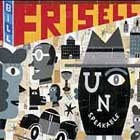 "My records are much less jazzy than I often am live. I'm a big-time explorer. I love the risk of jazz. I love the risk of improvisation and of difficulty. It's a very rigorous kind of music. I listen to lots of different kinds of music, but I have listened to a lot of jazz. Recently I've been obsessed with a new Coltrane/Monk album ( Thelonious Monk Quartet with John Coltrane at Carnegie Hall) and I've gone back through all my Monk records and I'm listening to those. Almost everything I've transcribed has been jazz. Lester Young and Sonny Rollins and Coltane. I think I transcribed all of Crescent [Coltrane] when I was 15 or something.
"My records are much less jazzy than I often am live. I'm a big-time explorer. I love the risk of jazz. I love the risk of improvisation and of difficulty. It's a very rigorous kind of music. I listen to lots of different kinds of music, but I have listened to a lot of jazz. Recently I've been obsessed with a new Coltrane/Monk album ( Thelonious Monk Quartet with John Coltrane at Carnegie Hall) and I've gone back through all my Monk records and I'm listening to those. Almost everything I've transcribed has been jazz. Lester Young and Sonny Rollins and Coltane. I think I transcribed all of Crescent [Coltrane] when I was 15 or something.
"But it's a new world. People are listening to all sorts of stuff. It's hard to keep it in any one groove.
Is she a jazz musician?
"I think that's up for the critics to decide, I don't know. I might do a whole record of singing—I sing too. When I sing, it's nothing original and jazzy. I can't sing a jazz tune to save my life. When I sing, it's old country music and some blues and folk music. I explore a lot of folk music. I have a pretty versatile instrument and it's pretty easy for it to wander in different genres, and it has for a long time. It's portable. People just wander around with it on their back.
The jazz question may be interesting, but its answer is not a big deal.
There seems to be many different flavors to 12 Songs and the quirky titles found therein. It's folky, pastoral in places. Ethereal at times. Joyful, and other times moody. "I was thinking about lyrical qualities in a melody very much when I was writing it; playing like a singer, she says. "The album is very focused on the melodies and the composition, rather than blowing, like on some jazz records. So it has that slight pop sensibility, I guess. I'm focusing on the content of the composition.
"There's a little inside joke, which isn't so inside. There are other albums called 12 Songs, including one of the great albums ever, which is a Randy Newman record, called 12 Songs, which is just a fucking great record. There are some other ones. But that's one of my favorite records. It seems like a form that non-classical writers can fit their music into, similar to a string quartet or a symphony; all these unnamed forms of music people have been writing forever.
She's also fond of the band she assembled for the record, which include Frisell, who splashes intriguing lines throughout the violinist's melodies, and trumpeter Miles.
"Bill, I've played a ton with. With Ron [Miles] I've played a lot, always with Bill. He's tried to get me on a few of his gigs, which hasn't worked out for schedule reasons. I've played with Rachelle in her group. I was playing with her a lot right before I made that record. Doug Wieselman [clarinets] is just a wonderful player. Doug and Rachelle are really insightful in that world of improvisational music that's based in song. There are a lot of incredible jazz players that still can't really play songs. Songs have the feel of form; what it is to have a bridge and what that means in terms of the story of the lyric. Granted, there are no lyrics on the record.

"It's gotten pretty nice feedback, man, in terms of the press. It was named one of the best records of the year in the New York Times and all these other places. Somebody likes it, says Jenny with a chuckle. "That's great. I want to make music that the people like. That's not true for everybody, and I certainly don't think that's necessary. But that's where I'm coming from. So it is nice that people like it. That helps me hear something in it that I like.
Scheinman isn't sure what her fan base is and doesn't seem concerned. She's appreciative of her critical notices, and is warm to know her gigs at places like Barbes in Brooklyn keep bringing in an audience. Doors may be opening for her. But in the meantime, she keeps applying herself to her art. In particular, she has been concentrating on writing more material. At the time of this interview in December, she had spent three days immersed in it.
"I'm kind of a worker bee. I sit down and write and it's not always good. I'm not sure the stuff I wrote in the last three days is any good, but I spent 10 hours a day doing it., she says. "I do like writing. Stuff gets stored up. I think a lot of people are like that, at least people that create things. They have to release some of the information that gets stored in their brains. It's therapeutic in that way.
"I like working on things. The moment of getting the melody is usually pretty quick. Then I fuss with things forever. I don't really change notes, but I add some notes and I obsess on song structure. Simple things like whether the A section should repeat, little compositional things. ... The original melody and the gist of the tune comes in 5, 10 minutes. But the life of a composing process is pretty long.
"I sort of think of it as karmic. If you put your work in, then even if the good stuff doesn't come when you're doing your 10-hour day of practicing writing, then it pleases the muse and she'll come through with some good melodies at some inopportune time.
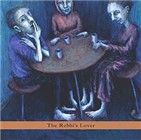 Scheinman grew up playing folk music with her family in a very rural part of northern California. She says, "My parents are New Yorkers. They moved out to California and raised me in probably one of the more remote places you can get in the States. It's a town of about 300 people. There were six people in my high school. It took two hours to get to town. It's way out there.
Scheinman grew up playing folk music with her family in a very rural part of northern California. She says, "My parents are New Yorkers. They moved out to California and raised me in probably one of the more remote places you can get in the States. It's a town of about 300 people. There were six people in my high school. It took two hours to get to town. It's way out there.
"My mom grew up with a lot of classical music. They were sort of fancy New York people. My dad's father was really into jazz. My father used to go see jazz when he was a kid. He was a regular at the Village Vanguard when he was young. Then he got taken away with the folk scene, the '50s east coast folk revival. He knows a million songs. He plays guitar. I grew up singing those, playing with him. There are folk songs, Beatles tunes. He was in Liverpool when the Beatles were starting. And a lot of jazz tunes. So I played those with him.
She took private piano and violin lessons. Her high school class was comprised of six students, a school "my parents and other adults created to avoid sending their kids two hours away to a public education facility, she says. But it was not underprivileged. She attended an arts camp and toured at times with a dance group, so the arts were always important. The education system may have been different, but not limiting. Scheinman was 16 when she attended Oberlin Conservatory and performed as a violinist.
The family traveled to the fiddle festivals where she won her competitions, and to New York City every year to visit relatives. They also went to Europe, where Jenny first encountered busking, something she would do from time to time in Frisco and the Big Apple.
Scheinman didn't stay at Oberlin, instead transferring to UC Berkeley where she graduated with honors in English literature in 1995. She considered using her degree to supplement her desire to play music, but was music's pull was stronger. "I started playing professionally when the small allowance from my dad was not paying rent, she says, laughing. "So I started busking. I was living in Santa Cruz, playing cafes. I started playing with the Hot Club of San Francisco (doing Django Reinhardt/Stephane Grappelli repertoire). I started driving up to San Francisco to do gigs and eventually moved up there. It turned into not only a need, but a passion to play. I was in lots of bands there.
Gig were varied in order to make money and learn the business. They included work with John Schott and Ben Goldberg, the Rova Saxophone Quartet, violinist/singer Carla Kihlstedt, and in a regional rock band called Charming Hostess. The Bay area was fruitful in another way. She met producer Lee Townsend, through whom she got involved in recording projects, and met musicians like Vinicius Cantuaria, which led her to Frisell.
In 1999, Scheinman made a decision to go east, to New York City.
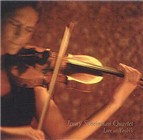 "I didn't know what would happen, she admits. "I wasn't so aware of a career. Certainly the gigs pay a lot less here [NYC]. Maybe 30 percent less. People out in the Bay area actually live there and make a living there. They don't tour. So they depend on the gigs there to make a living. I am sure there are people here that stay here all the time, but they have lots of private party gigs and club dates. I haven't totally gotten into that scene here.
"I didn't know what would happen, she admits. "I wasn't so aware of a career. Certainly the gigs pay a lot less here [NYC]. Maybe 30 percent less. People out in the Bay area actually live there and make a living there. They don't tour. So they depend on the gigs there to make a living. I am sure there are people here that stay here all the time, but they have lots of private party gigs and club dates. I haven't totally gotten into that scene here.
"I just came here to study. I was hearing all these people on recordings that actually lived here and did gigs at local places and I wanted to hear them. I'd been coming here every summer for a month or so, for a bunch of years. It was partly for family. There are some relatives here. It was familiar. Still dauntingly huge, but familiar.
"In the Bay area, I used to play this wonderful place called Bruno's every Wednesday for a while. That's where I really practiced leading a band and writing music. Improvising. I was really doing my own thing. It had its heyday when I was around there, she says. But the scene stagnated somewhat and musicians were leaving. "People leave, so I just went with everybody to here.
She's been getting gigs with people like Frisell and did some self- produced recordings with just bass and drums. In 2000, she did her first recording for a label, Live at Yoshi's (Avant). That was all-original material, as is the case on her two ensuing releases, The Rabbi's Lover (Tzadik, 2001) and Shalagaster (Tzadik, 2004), which led up to 12 Songs.
Her name is being mentioned in jazz polls, and her records have a following. But Scheinman seems unsure of what her "popularity is, and is not going to lose any sleep over it. Her music matters more.
"I don't really have a sense of that. If there's some big write-up in the New York Times, then people come. I play every Tuesday at Barbes, when I'm in town. The Barbes regulars know me., she says. "You just keep playing. I play with lots of different people. If I play at Barbes with Danny Barnes, all the banjo fanatics of New York hopefully will come. So maybe it diversifies my audience.
Even her connection with the enormously popular Norah Jones album skews her perspective or pushes her off center. After all, Jones performed behind Scheinman on gigs in Brooklyn before her sudden rise took her on the road.
"That was a big exciting record. It was great for that world of songwriters. It was cool. I'm a good friend of hers, but I didn't tour with her. I've performed with her a bit here, with her music. An she's played with me a bit. The other friends of ours that were actually in her band disappeared for three years on the road with her.
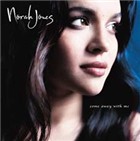 "It's weird, she says, finding a surreal humor in it. "Probably George Bush has heard me, come to think of it. He's probably heard me on Norah Jones' record. If 20 million records are sold, they've got to get to people's ears you'd never imagine.
"It's weird, she says, finding a surreal humor in it. "Probably George Bush has heard me, come to think of it. He's probably heard me on Norah Jones' record. If 20 million records are sold, they've got to get to people's ears you'd never imagine.
For the future, Scheinman said she is looking for a manager and a record label. "A long time ago I did another record, sans label. I don't think I'll do that again. I play lots of different kinds of stuff and I'm quite passionate about a lot of it. I would love to find a label that would be interested in the various sides of me, that would embrace a more complex character, or a more realistic version of a musician.
"But if I have to wander around among labels, doing my folk thing here and my jazz thing somewhere else, that's cool too. I've been tremendously lucky with all that. I'm writing. I'm doing a tour in Europe with a string quartet. I want to write for that. I have a lot of music already that works very well for it. So if I don't write anything new that I really like, we have lots of repertoire. I set up the band, but I think it will be a pretty collaborative thing. I hope everyone will write.
"I was real inspired by the big extravagant CD release party with the 12 Songs plus the 20 strings. That's a lot to ask a record company to go for, especially since I'm not guaranteed to make anybody any money. I would really love to record that band. I might figure out a way to do that and write some music for that.
 Scheinman says she's settled into New York and finds things stable now, even if the club scene isn't as good these days. "I was interested in the downtown scene when I moved here. Dave Douglas, Mark Feldman, a bunch of different players. Early Bill Frisell records, that were part of the downtown scene. I'm less aware of what's going on in that scene, among those players now. Maybe it's a little bit fragmented, I'm not sure. It's so big, I don't know how to describe the scene.
Scheinman says she's settled into New York and finds things stable now, even if the club scene isn't as good these days. "I was interested in the downtown scene when I moved here. Dave Douglas, Mark Feldman, a bunch of different players. Early Bill Frisell records, that were part of the downtown scene. I'm less aware of what's going on in that scene, among those players now. Maybe it's a little bit fragmented, I'm not sure. It's so big, I don't know how to describe the scene.
She notes, "Brooklyn is taking on a new life. In the last five years, a lot of music has moved to Brooklyn. That's partly economical. Clubs can't afford to stay in Manhattan, so they move to Brooklyn. Also, a lot of musicians can't afford to live in Manhattan, so they move to Brooklyn. There are more musicians out here. Barbes is a wonderful club. Little places in Williamsburg are great.
Jenny likes where she is right now, musically and career-wise. But there are more roads to travel down.
"Yeah. I've been at the end and the beginning of something else. We're at the beginning of the year. I'm at the end of the 12 Songs record. So it's exciting and challenging, she says, "and a little scary.
Selected Discography
Jenny Scheinman, 12 Songs (Cryptogramophone, 2005)
Bill Frisell, Richter 858 (Songlines, 2005)
ROVA Orkestra, Electric Ascension (Atavistic, 2005)
Scott Amendola Band, Believe (Cryptogramophone, 2005)
Jenny Scheinman, Shalagaster (Tzadik, 2004)
Bill Frisell, Unspeakable (Nonesuch, 2004)
Carla Bozulich, I'm Gonna Stop Killing (Independent, 2004)
John Zorn, Voices in the Wilderness (Tzadik, 2003)
Bill Frisell, The Intercontinentals (Nonesuch, 2003)
Scott Amendola Band, Cry (Cryptogramophone, 2003)
Jenny Scheinman, Rabbi's Lover (Tzadik, 2002)
Norah Jones, Come Away With Me (Blue Note, 2002)
Pharoah's Daughter, Exile (Knitting Factory, 2002)
Vinicius Cantuaria, Vinicius (Transparent Music, 2001)
Jenny Scheinman Quartet, Live at Yoshi's (Avant, 2000)
Gabriela, Viento Rojo (Intuition, 2000)
Dubtribe Sound System, Bryant Street (Imperial Dub, 1999)
Hot Club of San Francisco, Live (Hot Club, 1996)
Photo Credits:
Top Photo: Solange Gould
Center Performance Photo: Michael Wilson
Bottom Photo: Monica Frisell
 | Free Download Song of the Open Road |
Tags
PREVIOUS / NEXT
Jenny Scheinman Concerts
Support All About Jazz
 All About Jazz has been a pillar of jazz since 1995, championing it as an art form and, more importantly, supporting the musicians who make it. Our enduring commitment has made "AAJ" one of the most culturally important websites of its kind, read by hundreds of thousands of fans, musicians and industry figures every month.
All About Jazz has been a pillar of jazz since 1995, championing it as an art form and, more importantly, supporting the musicians who make it. Our enduring commitment has made "AAJ" one of the most culturally important websites of its kind, read by hundreds of thousands of fans, musicians and industry figures every month.


